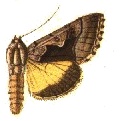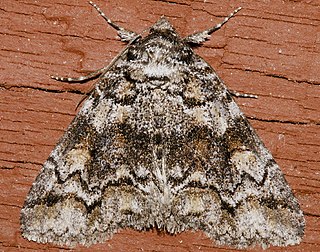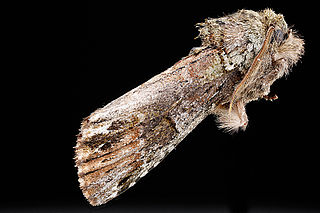
Schinia, commonly called flower moths, is a large genus of moths belonging to the family Noctuidae. The genus has a Holarctic distribution with the vast majority of species being found in North America, many with a very restricted range and larval food plant.

Hypenodes is a genus of moths of the family Erebidae erected by Henry Doubleday in 1850.

Oligia is a genus of moths of the family Noctuidae described by Jacob Hübner in 1821.

Euxoa medialis, the median-banded dart, is a moth of the family Noctuidae. The species was first described by Smith in 1888. It is found in North America from southern Manitoba and central Wisconsin, west to southwest Alberta and California; north to southern Alberta and south to south-central Mexico.
Abagrotis duanca is a moth of the family Noctuidae first described by Smith in 1908. It is found in the Pacific Northwest of North America. In Alberta it has been collected only in the extreme southeastern corner.
Abagrotis nefascia is a moth of the family Noctuidae first described by Smith in 1908. It is found in North America from Alberta and British Columbia down through Massachusetts to California. The species is listed as threatened in the US state of Connecticut.
Abagrotis trigona, the luteous dart, is a moth of the family Noctuidae. The species was first described by Smith in 1893. It is found in North America from western South Dakota and south-western Manitoba west across southern Saskatchewan and Alberta to Vancouver Island, south to the Mexican border. There is also a disjunct population in Ohio.

Acronicta quadrata, the quadrate dagger moth, is a moth of the family Noctuidae. The species was first described by Smith in 1908. In Canada, it occurs across the wooded area north to the southern edge of the boreal forest. It extends from western Quebec, west to the Rocky Mountains in Alberta and north-western British Columbia. It is widespread in the western parts of the United States.
Amphipoea interoceanica, the interoceanic ear moth, strawberry cutworm moth or strawberry cutworm, is a moth of the family Noctuidae first described by Smith in 1899. It is found from coast to coast in the United States. In Canada from Quebec west to Alberta, Nova Scotia.

Syngrapha orophila is a moth of the family Noctuidae first described by George Hampson in 1908. It is found in western North America from extreme northern British Columbia and the Queen Charlotte Islands, south and east to southern Oregon, western Wyoming and Montana and western Alberta.

Raphia frater, the brother moth or simply the brother, is a moth of the family Noctuidae. It is found from Nova Scotia west, across the forested regions of Canada to British Columbia, south to Mississippi in the east. The southern limits in the west are uncertain due to confusion with several closely related species or forms.
Phalaenostola hanhami, also called Hanham's owlet or Hanham's snout moth, is a litter moth of the family Erebidae. The species was first described by J. B. Smith in 1899. It is found in North America from Nova Scotia, west across Canada to central Alberta, south to Massachusetts and New York.

Zale duplicata, the pine false looper zale, pine false looper, banded similar-wing or grey similar-wing, is a moth of the family Noctuidae. The species was first described by Charles J. S. Bethune in 1865. It is found in woodlands and forests from British Columbia to Nova Scotia, south to the mountains of Georgia and Texas.

Trionyx is a genus of softshell turtles belonging to the family Trionychidae. In the past many species in the family were classified in this genus, but today T. triunguis, the African or Nile softshell turtle, is the only extant softshell still classified as Trionyx. The other species still assigned to this genus are only known from fossils. T. triunguis is a relatively large, aquatic piscivore.

Coelodasys unicornis, the unicorn caterpillar moth, unicorn prominent or variegated prominent, is a species of moth in the family Notodontidae. It was first described by James Edward Smith in 1797 and is found in North America south of the Arctic.

Hypenodes humidalis, the marsh oblique-barred, is a moth in the family Erebidae. The species was first described by Henry Doubleday in 1850. It is found in most of Europe and across the Palearctic to Siberia.
Hypenodes sombrus is a species of moth in the family Erebidae. It was described by Douglas C. Ferguson in 1954. It is found in Canada from Nova Scotia to western Alberta. The habitat consists of bogs, cattail marshes, dry pine and other woodlands.

Phaeoura quernaria, the oak beauty, is a moth of the family Geometridae. The species was first described by James Edward Smith in 1797. It is found in eastern North America, occurring as far west as east-central Alberta. The habitat consists of aspen-cherry shrubland.

Orthosia hibisci, the speckled green fruitworm moth, is a moth of the family Noctuidae. It is found in most of North America, except in desert regions. The habitat consists of moist forests, riparian, agricultural and urban areas.

Mesapamea fractilinea, the broken-lined brocade, is a species of cutworm or dart moth in the family Noctuidae.












